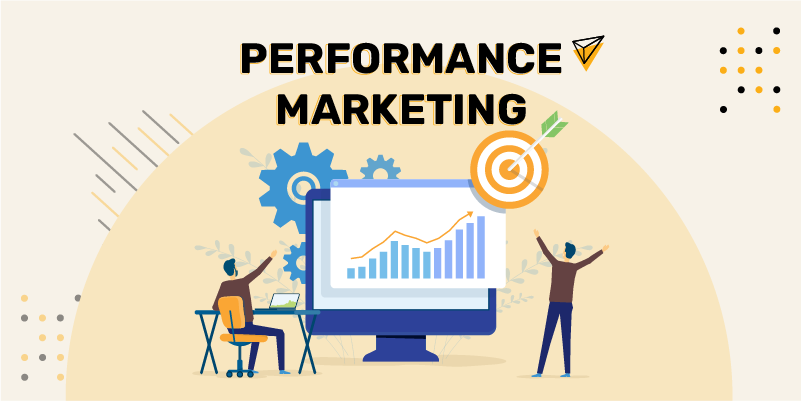Performance Marketing
Performance marketing plays a crucial role in the operations of digital agencies, serving as a cornerstone for driving tangible results and maximizing ROI for clients. Digital agencies specialize in leveraging various online channels and technologies to promote brands, products, and services, and performance marketing aligns perfectly with their goals of delivering measurable outcomes and demonstrating value to clients.
Performance marketing is a dynamic and results-oriented approach to online advertising that has revolutionized the way businesses promote their products and services. Unlike traditional advertising methods that require upfront payments regardless of performance, performance marketing operates on a pay-for-results basis, where advertisers only pay when specific actions, such as clicks or conversions, are achieved. This model has empowered advertisers to track and measure the effectiveness of their campaigns more accurately, ensuring a clear return on investment (ROI) and maximizing the efficiency of their marketing budgets.
One of the key distinctions of performance marketing lies in its focus on driving measurable actions and attributing ROI to each marketing activity. In traditional advertising, businesses often invest substantial sums of money upfront with no guarantee of results. However, with performance marketing, advertisers have the flexibility to define their desired outcomes, whether it’s generating leads, driving sales, or increasing website traffic, and only pay when these objectives are met. This pay-for-performance model not only mitigates financial risk for advertisers but also incentivizes marketing partners and affiliates to optimize their efforts to deliver tangible results.
Affiliate marketing is a prime example of performance marketing in action. In affiliate marketing, advertisers partner with affiliates who promote their products or services on their platforms, such as websites, blogs, or social media channels. Affiliates earn a commission for each qualifying action generated through their promotional efforts, such as clicks, leads, or sales. This results-driven compensation structure aligns the interests of advertisers and affiliates, driving collaboration and mutual success.
Another distinguishing feature of performance marketing is its emphasis on measurable metrics and key performance indicators (KPIs) to evaluate campaign effectiveness. Advertisers have access to a wide range of metrics, including cost per mille (CPM), cost per click (CPC), cost per action (CPA), and lifetime value (LTV), among others, which provide valuable insights into the performance and ROI of their marketing initiatives.
Cost per mille (CPM) measures the cost of advertising to one thousand viewers or impressions and is commonly used for brand exposure campaigns. Cost per click (CPC) calculates the cost incurred by advertisers for each click on their ads and is prevalent in pay-per-click (PPC) advertising models. Cost per action (CPA) tracks the cost of specific actions taken by users, such as making a purchase or signing up for a newsletter, providing advertisers with a clear understanding of the cost-effectiveness of their marketing efforts. Lifetime value (LTV) estimates the total revenue expected from a customer over their entire relationship with a business, helping advertisers assess the long-term profitability of their marketing strategies.
Performance marketing encompasses various tactics and channels, including search engine marketing (SEM), native advertising, social media advertising, and programmatic advertising. SEM involves placing paid ads on search engine results pages (SERPs) to target users actively searching for relevant products or services. Native advertising seamlessly integrates promotional content into the user experience, enhancing engagement and brand awareness. Social media advertising enables advertisers to reach highly targeted audiences based on demographics, interests, and behaviors, driving user engagement and conversions. Programmatic advertising leverages automation and data-driven algorithms to optimize ad placements and target audiences effectively, maximizing ROI.
The advent of artificial intelligence (AI) and natural language processing (NLP) technologies has further enhanced the capabilities of performance marketing. AI-powered tools and platforms analyze vast amounts of data to identify trends, patterns, and audience insights, enabling advertisers to optimize their campaigns for maximum impact. ChatGPT, a state-of-the-art NLP model, has emerged as a valuable tool for generating ad copy, content assets, and personalized messaging, streamlining the creative process and enhancing campaign performance.
Building a successful performance marketing strategy requires careful planning, execution, and optimization. Advertisers must define clear goals, identify target audiences, allocate budgets effectively, create compelling content, and continually analyze and iterate based on performance data. By leveraging the diverse array of performance marketing tactics and technologies available, businesses can create highly effective campaigns that drive measurable results and deliver significant ROI.
Building a performance marketing strategy involves several key steps to ensure effectiveness and success:
- Define your goals: Clearly outline your objectives and what you aim to achieve with your performance marketing efforts. Whether it’s increasing sales, generating leads, boosting website traffic, or improving brand awareness, defining your goals will guide your strategy.
- Identify your target audience: Understand who your ideal customers are, their demographics, interests, behaviors, and pain points. This information will help you tailor your messaging, targeting, and tactics to resonate with your audience effectively.
- Establish a budget: Determine how much you’re willing to invest in your performance marketing campaigns. Allocate your budget across different channels, campaigns, and tactics based on your goals, audience, and expected ROI.
- Choose the right channels and tactics: Select the most suitable channels and tactics to reach your target audience and achieve your goals. Consider options such as search engine marketing (SEM), social media advertising, display advertising, email marketing, affiliate marketing, and content marketing.
- Create engaging content: Develop compelling and relevant content that resonates with your audience and encourages them to take action. This could include ad copy, landing pages, blog posts, videos, info graphics, and other multimedia assets.
- Optimize for mobile: Ensure that your campaigns, websites, and content are optimized for mobile devices, as mobile usage continues to grow. Mobile optimization improves user experience, engagement, and conversions, especially for users accessing content on smartphones and tablets.
- Conduct keyword research: Perform keyword research to identify relevant keywords and phrases that your target audience is searching for. Use this insight to optimize your content, ad campaigns, and website for better visibility and reach in search engine results.
- Implement tracking and analytics: Set up tracking tools and analytics platforms to monitor the performance of your campaigns in real time. Track key metrics such as clicks, conversions, cost per acquisition (CPA), return on ad spend (ROAS), and other relevant KPIs to evaluate campaign effectiveness and make data-driven decisions.
- Iterate and optimize: Continuously monitor and analyze your campaign performance to identify areas for improvement and optimization. Test different ad creatives, targeting options, messaging, and landing page designs to refine your approach and maximize results.
- Measure ROI: Evaluate the return on investment (ROI) of your performance marketing efforts by comparing the cost of your campaigns to the revenue generated or other desired outcomes achieved. Adjust your strategy and budget allocation based on the ROI of each campaign to optimize performance and drive better results over time.
Performance marketing represents a paradigm shift in the field of online advertising, offering advertisers greater control, accountability, and transparency in their marketing efforts. By focusing on measurable outcomes, leveraging advanced technologies, and optimizing campaign strategies, businesses can achieve tangible results and maximize the impact of their marketing investments in today’s competitive digital landscape.





